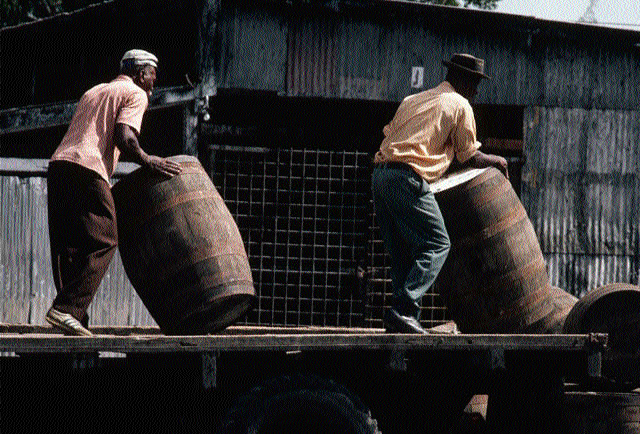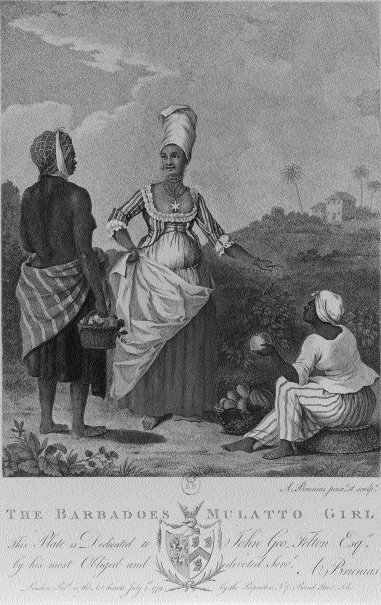Although Barbados was well known to Spanish and Portuguese sailors at least a century earlier, Great Britain did not become acquainted with the island until the seventeenth century. On May 14, 1625, a ship led by the British captain John Powell stopped to explore the island. After verifying that it was uninhabited, Powell returned to England to formalize the plan to establish a permanent settlement on Barbados. Two years later, on February 17, 1627, a British ship carrying 10 African slaves and more than 80 British colonists landed on the western side of the island, at a site later named Holetown Village. There were few colonists who could afford to purchase slaves, so most had to work the land themselves. But even though the slave population was small - according to the records of a British merchant there were less than 50 in 1629 - they occupied a central position in the Barbadian economy from the onset. African and Amerindian slaves were forced to perform some of the most physically demanding work, such as constructing colonial buildings and clearing land for colonial homes. Their status as the property of white settlers was formalized in 1636 when colonial officials passed a law declaring all slaves who were brought into Barbados - both Amerindian and African - to be enslaved for life. This law was extended to include the offspring of slaves. During this period there were only 22 free people of color on the island - Amerindian farmers from the Guianas brought in to teach the settlers new agricultural techniques.
European indentured servants were the primary source of labor during most of the island's history throughout the seventeenth century. Poor, uneducated laborers were recruited in England, Scotland, and throughout Europe to work on tobacco and cotton plantations. Although they could not be enslaved under law, indentured servants during this period were considered tenants at will. They could not own the land they worked and were unable to leave the plantation without permission in the form of a pass from their employer. The harsh conditions of indentured servitude made it increasingly difficult for Barbadian tobacco and cotton planters to recruit white labor. As the labor supply dwindled, so did the capacity of the island's tobacco and cotton producers to compete with their international competitors. A drop in world tobacco prices in the early 1640s further weakened the island's economy.
The Emergence of the Sugar Industry
For years Barbadian planters had searched avidly for alternatives to tobacco and cotton as sources of revenue. In 1642 Dutch merchants introduced them to a far more lucrative crop - sugar cane. Before 1642 sugar was used in Barbados mainly as fuel, in the production of rum, and to feed livestock. By 1644 large sugar cane plantations were producing sugar exports across the island. The political infrastructure of Barbados drew wealthy landowners; with political participation tied to landowning, they reigned supreme. The planter elite, or so-called plantocracy, excluded all nonwhites and most poor whites from participation in government affairs. In the words of historian Hilary Beckles: "Partly because of these political and constitutional developments, Barbados emerged in the mid-1640s as perhaps the most attractive colony in the English New World." Land values doubled and tripled in the 1640s as wealthy British capitalists flocked to Barbados to commence the operation of sugar plantations.
Escalation of the Slave TradeThroughout the seventeenth and eighteenth centuries slaves from various parts of West Africa, including the Gold Coast (present-day Ghana) and Benin, were packed in crowded European vessels bound for the Caribbean. The transatlantic slave trade carried between 10 and 20 million African slaves to colonial plantations throughout the world. By the mid-seventeenth century Barbados was already a leading participant in the slave trade and one of the most profitable European colonies in the world. In 1645 there were an estimated 5680 African slaves in Barbados. In 1685, 40 years later, their numbers had soared to nearly 60,000. Historian Philip Curtin estimates that by 1700 there were 134,500 African-born slaves in Barbados.
Seventeenth-Century Slave Society
Slaves in Barbados spoke a variety of languages and represented various ethnic groups, including the Igbo, Asante, Fante, Ga, Fon, and Yoruba. Most were forced to work on sugar plantations, where they cut and processed sugar cane. The highly labor-intensive work was performed in conditions of severe heat. One of the most physically demanding aspects of sugar production was grinding the cane, which slaves were forced to do by hand.
Despite the 4-to-1 ratio of slaves to whites in Barbados as early as 1685, the thriving slave trade of the late seventeenth and early eighteenth centuries had an even more dramatic effect on the demographic landscape. As the African presence increased in Barbados, white indentured servants, who at one time had been the primary source of labor, began to question their place in the island's future. At the turn of the eighteenth century white indentured servants began leaving Barbados in waves.
More than 30,000 whites emigrated to neighboring islands throughout the first half of the eighteenth century. The racial imbalance created by this "white flight" placed the colony's white plantation owners in an uncomfortable position. They were intimidated by the sheer size of the slave labor force and its potential for rebellion, but they were dependent on the cheap and seemingly inexhaustible supply of African slaves. Colonial officials responded to the racial imbalance by institutionalizing white hegemony.
Black CodesOfficials began by reemphasizing, and in some cases, strengthening the island's slave codes, that is, laws regulating the behavior of slaves. Colonial officials had already passed a series of slave codes in 1661, 1676, 1682, and 1688, creating one of the most repressive political and economic systems in the slaveholding Caribbean. By the mid-eighteenth century Barbadian law prohibited slaves from leaving their plantations without permission from their owners and barred them from beating drums, blowing horns, or playing other loud instruments - tools enabling slaves who spoke different languages to communicate with each other (see Stono Rebellion). Barbados enacted its own version of the Fugitive Slave Law by requiring all whites to return runaway slaves to colonial officials. The law was lenient toward a master who intentionally killed a slave, requiring him only to pay a fine of $15. Those who killed their slaves "unintentionally" often escaped with no fine. The Barbadian Slave Codes served as models for other slave colonies in the Caribbean, including Jamaica and Antigua, which passed similar laws in 1664 and 1702, respectively.